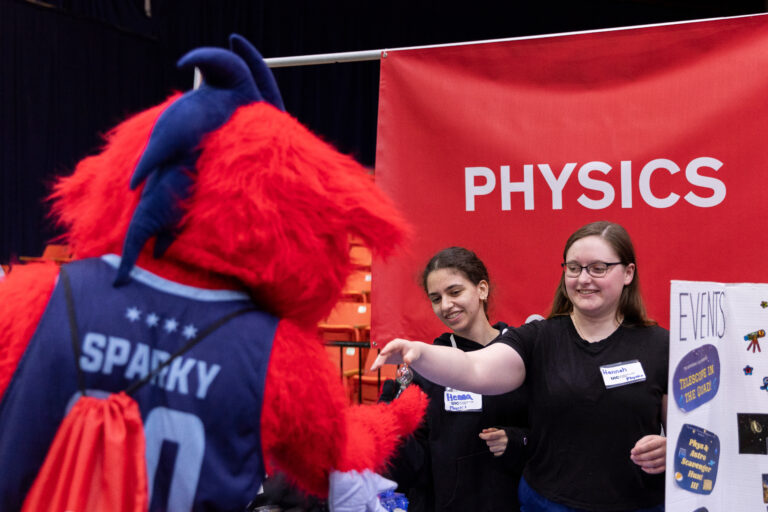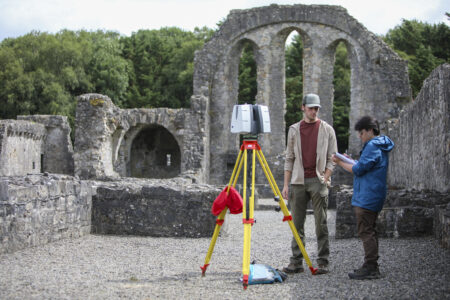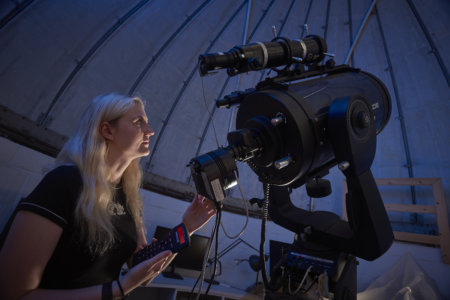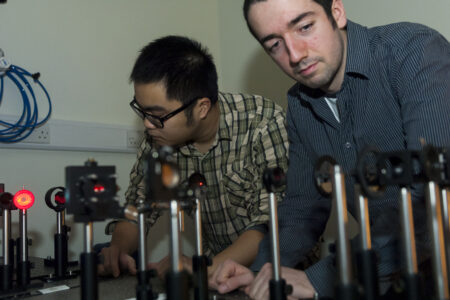
Physics is one of the most demanding sciences, and it’s easy to see why. Mastering physics requires a strong foundation in advanced mathematics, including calculus, linear algebra, and differential equations, areas that can be difficult to navigate. Beyond math, understanding abstract concepts like quantum mechanics and relativity can be daunting too.
But don’t let that scare you off. The difficulty is matched by the rewards. Physicists are in high demand, with job growth expected to increase by 7% from 2023 to 2033. And with salaries ranging from US$67,450 to US$208,000, the field offers both professional and financial rewards.
If you’re up for the challenge, here are three physics schools in North America that can help you unlock your potential and launch a rewarding career.

UIC’s faculty commitment to research excellence and quality education ensures you gain from their expertise. Source: University of Illinois Chicago
University of Illinois Chicago
The Department of Physics at the University of Illinois Chicago (UIC), Chicago’s only R1 (very high research activity) public university, offers many opportunities for students to grow academically and professionally. Students from all backgrounds come to UIC’s campus, near the heart of downtown Chicago and close to the Argonne and Fermi National Laboratories, to study with UIC’s award-winning faculty.
UIC’s Physics faculty are world-leading experts in biological, condensed matter, materials, nuclear, and particle physics. Nationally, the Department consistently ranks among the top in research productivity – currently fourth in research dollars per grant, ninth in articles per faculty member, nineteenth in grant dollars per faculty member, and thirtieth in citations per faculty member.
In the field of condensed matter physics, the Department covers a wide range of research areas, including electronic structure, surface and interface physics, complex systems and fluids. Professor Russell Hemley directs research on the high-pressure behaviour of earth and planetary substances. His work involves studying hydrogen transformations under extreme pressures, synthesising superhard materials, superconductors, magnetic materials, and so much more.
Using electron microscopy, Dr. Robert Klie’s Nanoscale Physics Group studies the function and properties of energy storage, conversion, and quantum computing materials at the atomic scale. The Group is advancing cutting-edge methods for characterizing liquid-phase, cryo- as well as high-temperature measurements of a material’s local atomic and electronic structures.
The High-Energy Nuclear and Particle Physics Research Groups explore the fundamental building blocks of the universe at the smallest distance scales using state-of-the-art data analysis and detector technology. These teams are part of leading global research efforts, such as the STAR Collaboration at the Relativistic Heavy Ion Collider (RHIC) and the CMS experiment at the European Organisation for Nuclear Research (CERN) in Switzerland. The Nuclear Physics Group aims to understand how matter behaves under the extreme conditions created during high-energy heavy-ion collisions. The Particle Physics Group uses proton-proton collisions to search for answers on the physical laws governing the evolution of the early universe.
While at other universities, such cutting-edge research is often reserved for PhD candidates and professors, UIC bucks this trend. At UIC, students are encouraged to get involved in research from the early stages of their academic journey. UIC undergraduates aren’t just sitting in lectures — they’re out working on real projects with federal grant-funded investigators. Examples include using state-of-the-art electron microscopes, extreme pressure studies, and collaborating on projects at the world’s largest particle accelerators. The Undergraduate Research Experience makes it easy to get involved, find funding, join events, and showcase your work.
Discover excellence in physics education and research at UIC.

The University of Miami, based in one of the world’s most vibrant and diverse cities, offers various degrees through its 12 schools and colleges. Source: University of Miami
University of Miami
The Physics Department of the College of Arts and Sciences at the University of Miami is dedicated to providing you with a transformative education. Here, you have the freedom to shape your academic journey through flexible degree options. Undergraduate programmes include majors and minors in pure physics, marine science and physics, applied physics, or dual majors that combine physics with biology or chemistry.
Graduate programmes provide a foundation in research, complemented by teaching opportunities that prepare you for leadership in science and education. From astrophysics and cosmology to complexity and biological physics, condensed matter physics, elementary particle physics, optics, and quantum initiative, there’s a wide range of options to prepare you for rewarding careers in science and beyond.
For example, astrophysics and cosmology researchers measure cosmic microwaves and use supercomputers and data analysis to understand the structure and evolution of the universe. In condensed matter physics research, you will tackle topics like high-temperature superconductivity, many-body theory, and quantum computing. The optics group studies how light moves through the atmosphere, the ocean, and highly multiple scattering media like tissue.
Researchers in elementary particle physics concentrate on quantum field theory and string theory, which examine the fundamental rules of the universe. Lastly, the new complexity and biological physics group focuses on studying complex systems with applications in the life sciences. Their work contributes to solving challenges across biology and other fields.

At Santa Clara University, you’ll learn from professors who are as dedicated to teaching as they are to their research and scholarship. Source: Santa Clara University
Santa Clara University
Physics is a demanding field, but as long as you stay dedicated and use your resources to the best of your ability, success is well within reach. At Santa Clara University, the Department of Physics offers the tools that pave the way for your academic and professional achievement. Graduates have found their place in diverse industries, such as business, research and development, education and more.
What makes this department special is its dedication to you, the student. You can choose from several programmes, including the Bachelor of Science in Physics, the Bachelor of Science in Physics with a biophysics emphasis, and the Bachelor of Science in Engineering Physics. For those pursuing other majors, the department offers an academic minor in physics, along with a variety of elective courses.
Department faculty provide comprehensive learning experiences through lower- and upper-division lectures, interactive laboratory sessions, and collaborative research projects. Their expertise includes superconductivity, computational neuroscience, and cryogenic particle detectors. And they welcome students to join them.
Located in Silicon Valley, the department connects you to world-class research opportunities at institutions like the Ames Research Centre (NASA Ames), IBM’s Almaden Lab, Stanford University, and the Lawrence Berkeley National Laboratory. If that’s not enough, you can join summer research programmes backed by national labs, universities, and companies to take your learning even further, all while building skills that will shape your future.
*Some of the institutions featured in this article are commercial partners of Study International










